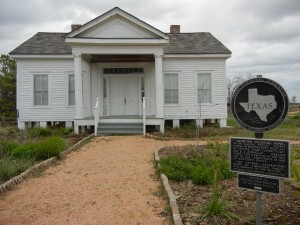
The Arnold-Simonton Home, at
Fernland Historical Park in
Montgomery, is the only structure in
Montgomery County
to be on the National Register of
Historic Places
|
|
MONTGOMERY –
Standing in the Old Methodist Churchyard
with the sound of modern life whizzing
by on Texas 105, it’s almost as if a
historical bubble exists around the
past, nearly forgotten with time. |
|
With nearly two dozen state historical
markers scattered throughout the city of
Montgomery, including the only national
registered marker in Montgomery County,
the town is a historical treasure chest
full of days gone by yet preserved for
future generations. |
“This town was one
of the first three Anglo settlements of
Stephen F. Austin,” said Brenda Beaven,
Montgomery Historical Society board
member. “ … This is one of the few areas
that has things left over from Stephen
F. Austin’s time.”
|
|
Many of
Montgomery’s historical markers are
within walking distance of the center of
town and the Montgomery Historical
Society provides a walking tour map. The
society is housed at the Davis Cottage,
308 Liberty St., which Judge Nathaniel
Hart Davis built in 1851 of logs cut in
1831 that were received as a legal fee. |
|
Once the county
seat, Montgomery houses the Montgomery
County historical marker, located in
front of the community building on FM
149 between College and Clepper streets.
The courthouse, which sat on this site,
had a sewing room as the county clothed
its own soldiers during the Civil War. |
|
This site also
contains the historical marker for
Charles Bellinger Stewart, the first
secretary of state in Texas, who also
signed the Declaration of Independence.
Stewart served as Montgomery County
district attorney and served three terms
as a state representative. On the back
side of the marker is a list of all
secretaries of state, as well as the
republic. |
|
The third marker on
this site commemorates the town of
Montgomery and was erected in 1936, like
many other markers, during the state’s
centennial, said Bill Ray Duncan,
president of the Montgomery Historical
Society. |
|
“Each marker gives
a little history of the home or
location,” he said. “It gives a good
background history of what you’re
looking at.” |
|
The only national
historical marker in Montgomery County
rests in Montgomery. The Arnold-Simonton
House, built in 1845, is an early Texas
Greek structure that was recently moved
to Fernland Historical Park, a park of
historical buildings that represent the
heritage of Montgomery County. The Greek
revival style began to appear in Texas
in the 1840s. |
|
Several other
historic houses can be found among the
city’s streets and provide insight in
the town’s history. The gazebo near City
Hall, on Old Plantersville Road,
contains maps to all the city’s
historical sites, Beaven said. |
|
The First State
Bank of Montgomery, 211 Liberty St., was
one of the first banks in Texas and is
the oldest existing commercial building
in the once-thriving trade center. The
bank’s safe was once stolen and the
vault still has scars from a robbery. |
|
About a block
southwest, the Old Baptist Church, 301
Pond St., and the Methodist Church, 309
Pond St. and also known as The Bells of
Montgomery, sit side by side with the
Old Montgomery Cemetery or Old Methodist
Churchyard, located at Texas 105 and
Pond Street, providing a shield between
the state highway and the religious
institutions. |
|
The cemetery,
seemingly forgotten in time, contains
the graves of soldiers from the War of
1812, the Texas War for Independence,
Mexican War and Civil War. Reuben
Jonathan Palmer and William S. Taylor
are buried in the Old Montgomery
Cemetery. Palmer, who died in 1868,
moved to Montgomery in 1856 and served
as a town lawyer, in the Ninth Texas
Legislature and in Secession Convention,
1861. Taylor, who died in 1869, was a
San Jacinto veteran. |
|
A block south of
Texas 105, on Old Plantersville Road is
the New Cemetery, which contains the
graves of Charles B. Stewart, a signer
of the Texas Declaration of Independence
and was the first secretary of state, as
well as the wife of Gen. Memucan Hunt, a
Texas soldier and statesman. The
cemetery also contains the graves of
Texas army soldiers and Civil War
veterans. |
|
The New Cemetery
was founded in 1868 to relieve the Old
Montgomery Cemetery, Beaven said.
Shortly after that, the tale is that
four horse thieves came into town and,
on adrenaline from their recent steal,
created chaos in town. However, men from
where the horse was stolen came into
town after the thieves and a gun battle
ensued west along College Street. When
it was all over, the four outlaws were
dead, but were refused burial in the Old
Montgomery Cemetery as, although it was
public, it was considered a church
cemetery. Therefore, the first three
burials in the New Cemetery were
outlaws. The fourth was buried nearby,
Beaven said. |
|
The Texas
Historical Commission approves
historical markers once a year, said
Sarah McClesky, historian for the
commission’s marker program. The
submitted location must be at least 50
years old and have historical
significance and/or be architecturally
significant. |
|
To date, there are
about 15,000 historical markers across
Texas, McClesky said, with nearly 275
applications submitted annually. |
|
“People can learn a
lot about people who live in that area
before them,” McClesky said about why
people should visit the historical
markers. “If you didn’t stop at that
marker, you might not know it even
existed.”
|

Vote Montgomery County TXGenWeb County of the Month
